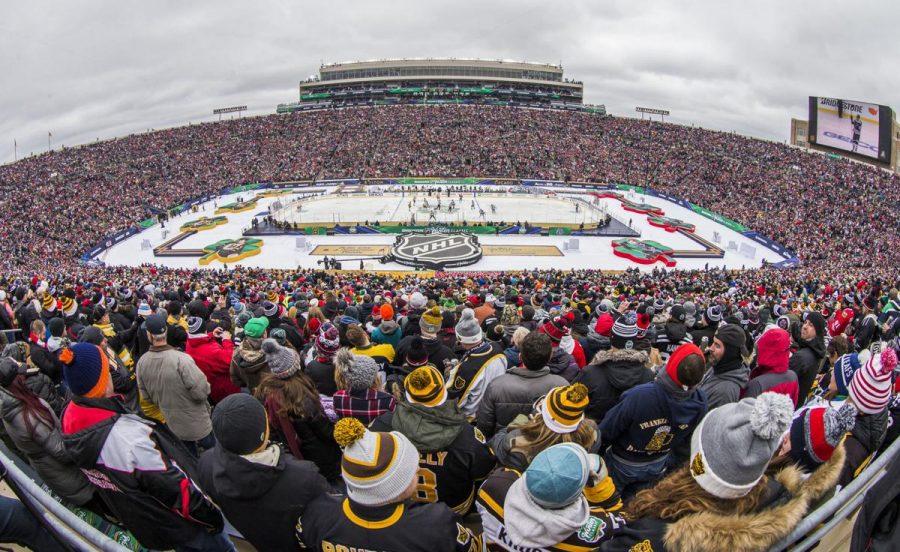On Jan. 1, 2020, the Nashville Predators will travel to Dallas, Texas to take on the Stars in what will be the southernmost outdoor NHL game in history.
The origins of hockey are highly debated. Some contest that the game was devised in Windsor, Nova Scotia by students at the King’s College while others speculate the game comes from the area around Dartmouth and Halifax, where it was first played as early as 1773. Although the precise location of the first hockey game may not be known, one thing is for certain, the game was born outside.
In 2003, the National Hockey League paid homage to the birth of the sport with the Heritage Classic, a regular season game played outdoors between the Edmonton Oilers and Montreal Canadiens at Commonwealth Stadium, a multipurpose venue in Edmonton, Alberta. At the time, the game set an attendance record for an NHL contest, with over 57,000 spectators coming to watch.
Since 2003, the NHL has played dozens of outdoor games at venues across North America, from Wrigley Field to Fenway Park to Yankee Stadium, and even at the Big House, where a crowd of over 104,000 people watched the Red Wings play the Maple Leafs, setting the current record for largest ever attendance at a hockey game.
This year, the NHL’s outdoor game, the Winter Classic, will be played a little bit farther south of the Big House, down past Wrigley Field, Fenway Park and Yankee Stadium. This year, it will be played in Texas.
On Jan. 1, 2020, the puck will drop at Cotton Bowl Stadium, marking the southernmost outdoor NHL game to ever be played. The Dallas Stars are slated to face the Nashville Predators, and the host city couldn’t be more excited.
“I can’t think of a better way to celebrate the great history of New Year’s Day at Cotton Bowl Stadium than by welcoming thousands of fans to witness the first ever outdoor professional hockey game in Texas,” said Dallas Mayor Mike Rawlings via WFAA8.
The Stars and Predators will meet once before their New Year’s Day game on Dec. 14, which will mark the two teams’ first contest since they faced each other in the first round of playoffs earlier in 2019. During that series, the Stars, who entered the post-season as a wild card team, were able to beat the Predators, the first-place team in the Central division, in six games. The series ended in dramatic fashion, with Stars’ forward John Klingberg scoring just over 17 minutes into overtime to send Dallas into the second round. This year, the Stars and Predators are locked in a tight battle within the Central Division. As of now, the teams are separated by only five points.
Building a hockey rink inside a football stadium is no easy task, and building a hockey rink inside a football stadium in Texas is even more complicated. Construction of the rink is set to begin on Dec. 17, when workers will lay down the initial foundation for the ice, which once finished will measure almost two inches thick. Between Dec. 17 and Jan. 1, the stadium will be transformed to prepare for the 70,000 or so fans that will file in to watch the game. The entire process will be streamed and visible to fans via NHL.com.
“You are not going to believe what this iconic stadium is going to look like,” said as reported by Nicholas Cotsonika for NHL.com.
Fans across the country who can’t make it to Texas can tune in to the game at 1 p.m. on NBC.
But perhaps those most excited for the game are those that will be playing in it.
“[I] wasn’t sure if I’d ever get the opportunity… but now this is a dream come true, and I’m really excited,” said Stars forward Tyler Seguin also reported by Nicholas Cotsonika for NHL.com.
Seguin’s excitement is definitely warranted; everything is bigger in Texas, and this year’s Winter Classic will unquestionably follow suit.












Earl Zukerman • Dec 5, 2019 at 3:29 pm
Very disappointed to see the continued use of “fake news” and mythology about the origins of hockey. The debate is centered around how one defines hockey. If you are talking about a structured game with organized teams, goaltenders, written rules and referees to enforce them, then there is no doubt that the game began in Montreal, with the first indoor contest on March 3, 1875.
If, however, you are talking about “stick-and-ball” games (eg shinny, shinty, bandy, field-hockey-on-ice, etc), with no organized structure, no formal teams, no rules, no goaltenders, etc., then evidence of the first such events like that that. appear to have taken place thousands of years ago on the European continent. The various forms of the game eventually made their way across the Atlantic, initially with the Franklin expedition to the arctic (now known as the Northwest Territories) around 1827, then primarily with British soldiers stationed in Kingston, Ont., in the 1840s and in Nova Scotia towns like Halifax, Dartmouth and Windsor during the 1860s , but it wasn’t until the game was formally organized in the mid-1870s by James G.A. Creighton, a Halifax native living in Montreal, that it actually took root and flourished exponentially.
A more accurate statement would have been:
The origins of hockey are highly debated and based on various definitions of the game. Early stick-and-ball events were played centuries ago in Britain and other European countries, which eventually made their way to the Northwest Territories in the 1820s, then Kingston, Ont., in the 1840s, followed by various towns in Nova Scotia in the 1860s.
Others point to the organized form of the game that began in Montreal in 1875, which implemented rules and structure that led to the game spreading across the continent.